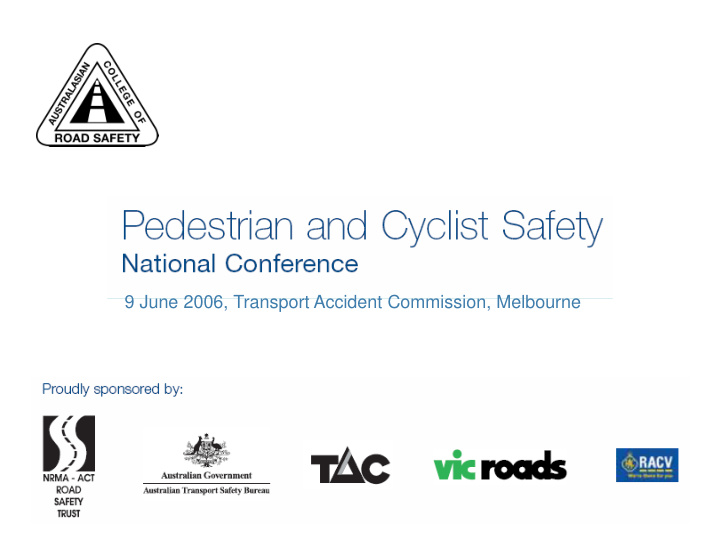



9 June 2006, Transport Accident Commission, Melbourne
Bridging the Gap between Safe System Thinking and Real-world Practice Bruce Corben Monash University Accident Research Centre 9 June 2006 Acknowledgments: Michael Lenné, Nimmi Candappa, Nicola Fotheringham, Karen Stephan, Christine Mulvihill, Max Cameron, Teresa Senserrick, George Rechnitzer, City of Port Phillip, City of Ballarat, VicRoads, TAC, DoJ
Walking in Perspective the original and fundamental form of human transport • Healthy • Personal independence • Social connection • Inexpensive – For individuals – For society • Flexible • Socially responsible transport – Non-polluting – Non-threatening to others – Very low cost • Walking vigorously promoted by governments and, therefore, should be possible at low-risk
Pedestrian Trauma in Australia The Next Ten Years • 2,500-3,000 deaths • ~30,000 serious injuries • Children, older people and the intoxicated will predominate
Trends in Pedestrian Deaths in Victoria (1980-2004)
Speed - a powerful determinant of injury risk Risk of pedestrian death by vehicle impact speed 100 80 Risk of Death (%) 60 40 -------- All-aged pedestrians -------- Older and child pedestrians 20 0 10 20 30 40 50 60 Impact Speed (km/h)
Over recent decades • We've enjoyed considerable success targeting road user behaviour – drink-driving – speed enforcement – restraint use – helmet wearing • Further gains will be far more difficult to achieve • A major shift in thinking is needed and is emerging
Australia’s Safe System A Guiding Road Safety Philosophy • Human error inevitable • Human biomechanical tolerances are limited! • A shared responsibility – system users must comply – system designers are ultimately responsible for designing and operating a safe system • Principal focus on managing kinetic energy of the system : – ideally, to prevent collisions – ultimately, to prevent serious injuries
“Safe System” Goals For its success, the “Safe System” seeks to • Keep sources of kinetic energy separated, wherever possible • Dissipate the maximum (safe) amount of kinetic energy during braking • Dissipate kinetic energy during a crash (through deformation of physical structures) and so avoid serious injuries
Kinetic Energy = ½ mv 2 That is, speed is 900 the principal 800 determinant of 700 kinetic energy Kinetic Energy (kJ) 600 500 – twice the speed, 400 four times the 300 kinetic energy 200 – three times the 100 speed, nine times 0 the kinetic energy 0 50 100 150 Velocity (km/h)
Kinetic energy to be managed in common urban speed zones Compared to 30 km/h 900 (representing low-risk) 800 700 Kinetic Energy (kJ) 600 – 2.8 times at 50 km/h 500 400 – 4.0 times at 60 km/h 300 – 5.4 times at 70 km/h 200 100 – 9.1 times at 80 km/h 0 0 50 100 150 Velocity (km/h)
Speed The Evidence is Compelling • The relationship between speed, and crash and injury risk is clear and powerful – but often not well understood • For pedestrians … “The safety level is determined by the speed level. Other countermeasures are only fine tuning” Source: Spolander, 1999
Research into Practice • Stopping distances as a function of travel speed • Visionary Research Model for pedestrians • Lower speed limits in pedestrian areas • Roundabouts designed specifically for pedestrians • Dwell on Red traffic signals for intoxicated pedestrians
Speed - a major determinant of crash risk Stopping Distance vs Travel Speed
Conceptual Structure of the Visionary Research Model Layers of “protection” The “Safe Human”
Crash risk (probabilities) Injury risk (kinetic energy) Human tolerance 1 2 Transfer of kinetic energy to pedestrian Kinetic energy per crash 3 4 Crash risk per exposure 5 Exposure
40 km/h speed limits in shopping strips
Pedestrian-friendly Roundabout Designs
“Dwell-on-Red” Traffic Signal Operation • Targets alcohol-affected pedestrians • Operates only during high-risk times and at high-risk locations/areas • Displays red to all directions when no vehicles approaching • As a result, more drivers approach during red signals, at lower speeds • Reverts to normal operation once approaching vehicles detected
Evaluations of New Traffic Engineering Measures • Reduced crash risk due to reduced vehicle approach speeds (at 30 metres) • Reduced injury risk due to reductions in potential impact speeds (at crosswalks) • Enhanced feeling of safety and convenience for pedestrians (at roundabout) • Minimal impact on drivers
What should be the main focus for pedestrians and cyclists? • Speed limits that explicitly recognise the realities of successfully managing kinetic energy • the laws of physics • the limits of human biomechanical tolerance to forces and energy • Infrastructure to support the chosen speed environment • Education, enforcement, promotion to support speed limits and use of infrastructure
From Philosophy to Practice Summary • Walking and cycling – offer many important benefits to the individual and to society – vigorously promoted by government; an obligation exists to make both low-risk • Safe System thinking will generate new, high-impact solutions • Momentum and support for the new approach are building worldwide • We know now, how to create low-risk traffic environments • Undertake demonstrations of innovative measures
9 June 2006, Transport Accident Commission, Melbourne
Recommend
More recommend